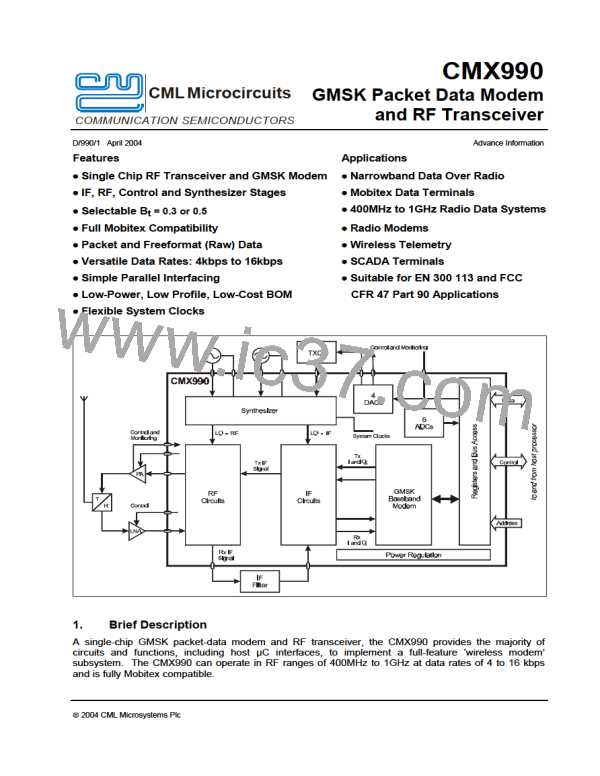GMSK Packet Data Modem and RF Transceiver
CMX990
Figure 10 Baseband Transmitter Signal Eye Diagrams
Rx Low Pass Filter
This filter is a low pass transitional Gaussian filter having a 3dB loss at 0.56 times the bit rate
(BT=0.56). It is used to reject HF noise to improve the BER.
Level Track and DPLL
These circuits, which operate only in receive mode, extract a bit rate clock from the received
signal and measure the received signal amplitude and dc offset. This information is then used
to extract the received bits and also to provide an input to the received Data Quality measuring
circuit.
5.1.2
Modem - µC Interaction
In general, data is transmitted over air in the form of messages, or ‘Frames’, consisting of a
‘Frame Head’ optionally followed by one or more formatted data blocks. The Frame Head
includes a Frame Synchronisation pattern designed to allow the receiving modem to identify
the start of a frame. The following data blocks are constructed from the ‘raw’ data using a
combination of CRC (Cyclic Redundancy Checksum) generation, Forward Error Correction
coding, Interleaving and Scrambling. Details of the message formats handled by this modem
are given in section 5.3.
To reduce the processing load on the host µC, this modem has been designed to perform as
much as possible of the computationally intensive work involved in Frame formatting and de-
formatting and (when in receive mode) in searching for and synchronising onto the Frame
Head. In normal operation the modem will only require servicing by the µC once per received
or transmitted data block.
Thus, to transmit a block, the host µC has only to load the unformatted (raw) binary data into
the modem's data buffer then instruct the modem to format and transmit that data. The
modem will then calculate and add the CRC bits as required, encode the result with Forward
Error Correction coding, interleave then scramble the bits before transmission.
In receive mode, the modem can be instructed to assemble a block’s worth of received bits,
de-scramble and de-interleave the bits, check and correct them (using the FEC coding) and
check the resulting CRC before placing the received binary data into the Data Buffer for the µC
to read.
The modem can also handle the transmission and reception of unformatted data, to allow the
transmission of special Bit and Frame Synchronisation sequences or test patterns.
ã 2004 CML Microsystems Plc
17
D/990/1

 CMLMICRO [ CML MICROCIRCUITS ]
CMLMICRO [ CML MICROCIRCUITS ]